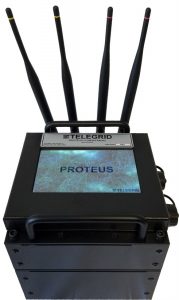The TELEGRID Proteus Wireless Mesh Network is a flexible, ad-hoc, self-forming wireless network based on the 802.11/b/g/n IEEE standard. It is composed of a collection of stationary, mobile, or airborne nodes formed by TELEGRID Proteus Radios that operate in the 900 MHz, 2.4 GHz and 5.8 GHz frequency bands. Ad-hoc networks operate without a centralized access point or existing infrastructure and are self-forming and self-healing. They can be deployed in stationary architectures, such as with unattended ground sensors, or in mobile or airborne applications where network topology is unpredictable.
The main element of the Proteus Wireless Mesh Network is the Proteus Radio which is a modular radio that can be configures by the network architect to satisfy specific requirements. This is done using the Proteus Node Configurator which helps determine which modules should be used and the total cost of the unit. The radio is composed of the following four basic modules:
- Dual Radio Module(2×2 MIMO)
- Power Supply/ Battery Module
- Sensors Interface Module
- Touch-Screen Display Module
Options available for the Dual Radio Module include:
- Two 2.4GHz Radios
- Two 5.8GHz. Radios
- One 2.4GHz/ 5.8GHz Radio and One 900MHz Radio
Options for the power supply module include AC power, DC power, rechargeable battery power or solar panel power.
The Proteus Radio design uses TELEGRID’s award winning Embedded Security Framework (ESF) which is a collection of DISA STIG/ SRG compliant encryption and authentication modules. Combining the ESF with a LINUX OS Container means sensor network integrators no longer have to worry about integrating security at the edge. The ESF handles all encryption and authentication including FIPS 140-2 compliance. Data Sheet
For a white paper on the how the Proteus network works Click Here

